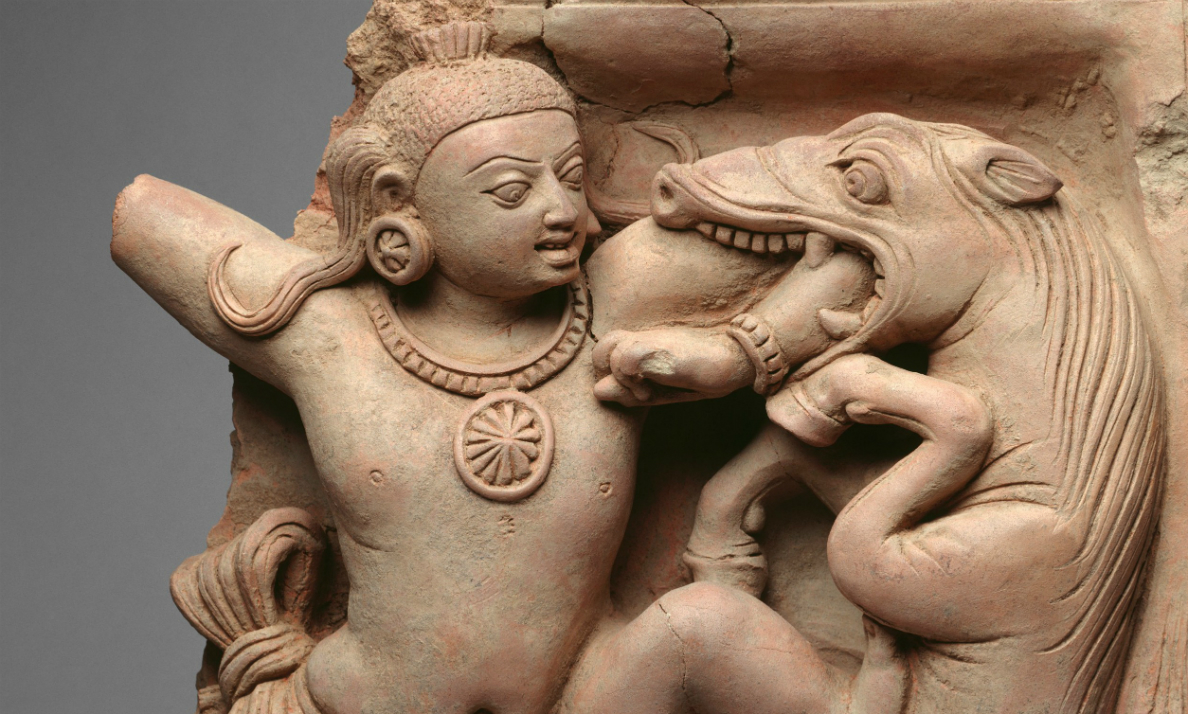
Detail, Krishna Killing the Horse Demon Keshi, Gupta period, 5th century, terracotta, 53.3 x 40.6. x 10.8 cm (The Metropolitan Museum of Art)
Origins of Hinduism
Unlike Christianity or Buddhism, Hinduism did not develop from the teachings of a single founder. Moreover, it has diverse traditions, owing to its long history and continued development over the course of more than 3000 years. The term Hindu originally referred to those living on the other side of the Indus River, and by the 13th century, it simply referred to those living in India. It was only in the 18th century that the term Hindu became specifically related to an Indic religion generally.
Hindus adhere to the principles of the Vedas, which are a body of Sanskritic texts that date as early as 1700 B.C.E. However, unlike the Christian or Islamic traditions, which have the Bible and the Koran, Hinduism does not adhere to a single text. The lack of a singular text, among other things, also makes Hinduism a difficult religion to define.
Hinduism is neither monotheistic nor is it polytheistic. Hinduism’s emphasis on the universal spirit, or Brahman, allows for the existence of a pantheon of divinities while remaining devoted to a particular god. It is for this reason that some scholars have referred to Hinduism as a henotheistic religion (the belief in and worship of a single god while accepting the existence or possible existence of other deities). Hinduism can also be described as a religion that appreciates orthopraxy—or right praxis. Because doctrinal views vary so widely among Hindus, there is no norm based on orthodoxy or right belief. By contrast, ritualized acts are consistent among differing Hindu groups.
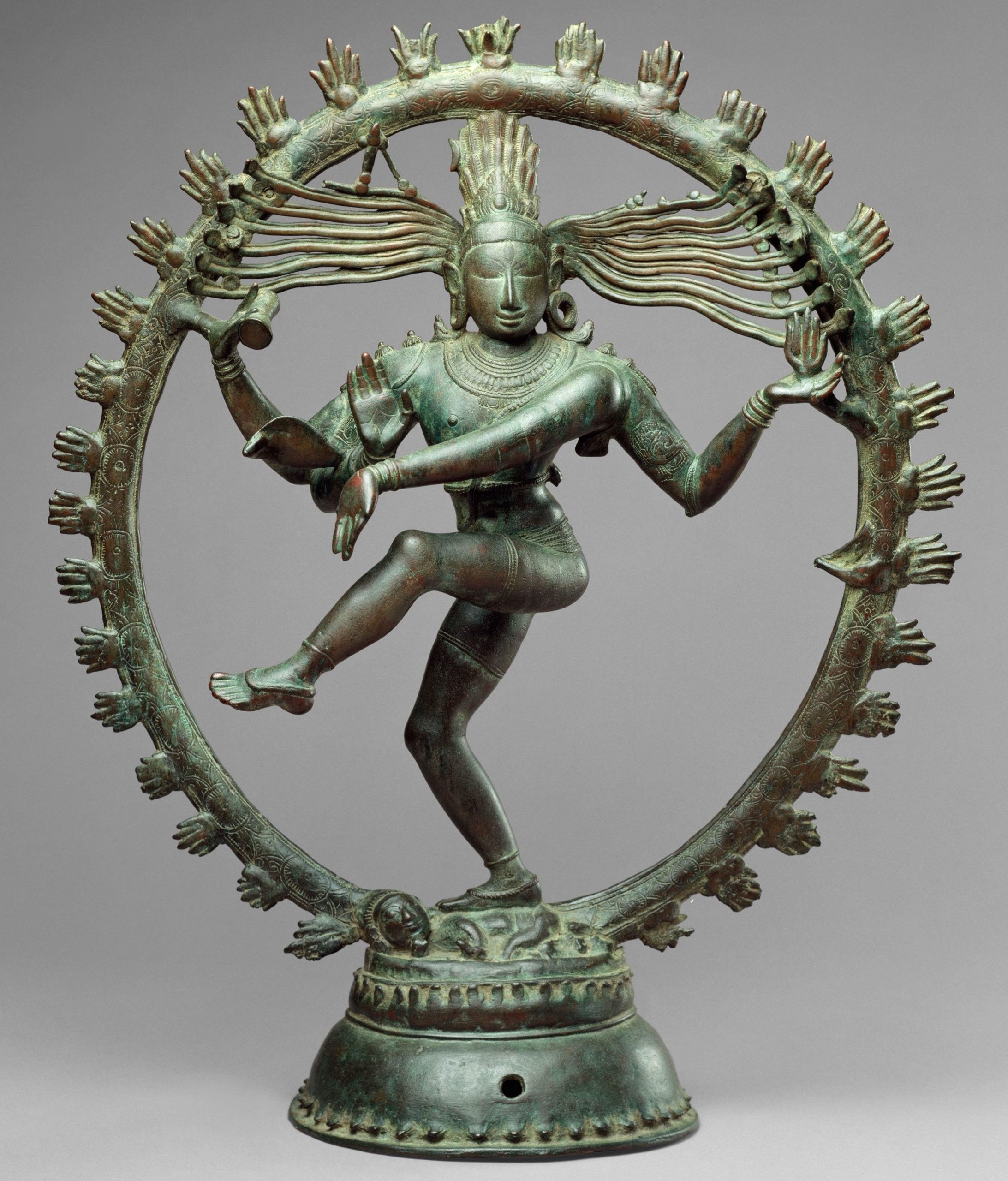
Shiva as Lord of the Dance (Nataraja), c. 11th century, Chola period, copper alloy, 68.3 x 56.5 cm (The Metropolitan Museum of Art)
Hindu gods and worship of the gods
Within the Hindu pantheon are a number of gods, goddesses, and deities; however, one entity is supreme, Brahman. Brahman is the Supreme Being; the One self-existent power; the Reality which is the source of all being and all-knowing. Enlightenment for the Hindu is recognizing that all things are united.
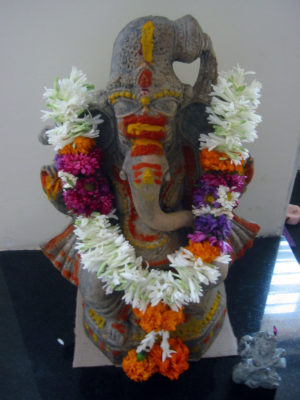
Adornment (alankara) of Ganesha murti in a home shrine, Bangalore, 2004 (photo: Dr. Cristin McKnight Sethi, CC BY-NC-SA 2.0)
Brahman is traditionally said to manifest on earth as the Trimurti: Brahma as the creator god; Vishnu, the preserver; and Shiva, the destroyer. Brahman manifests himself on earth in other gods so that he will be more knowable. With this said, for Hindus, reaching salvation is understanding that everything is in union. The different names and forms that a god can take are immaterial as they are essentially Brahman.
However, as human beings, we crave the protection of many gods, in particular those gods with a very specific power. Beyond the Trimurti are numerous Hindu gods and goddesses, such as Ganesha, the elephant-headed god, and Durga, the female warrior. Each god has a specific power and role. Ganesha, for example, is the lord of beginnings and the remover of obstacles. It is for this reason that images of Ganesha are present in Hindu temples, regardless of who the temple is dedicated. Durga, who is solicited for protection, is also equally sought by women for fertility.
These personal deities are called ishtadeva. Having an ishtadeva does not mean a worshipper forsakes other gods, but it does mean that they have a more personal relationship with their patron deity.

Krishna Killing the Horse Demon Keshi, Gupta period, 5th century, terracotta, 53.3 x 40.6. x 10.8 cm (The Metropolitan Museum of Art)
Hindu Worship
For Hindu worshipers, the concept of bhakti is important. Bhakti is the devotion, honor, and love one has for god. The physical actions, which one takes to express one’s bhakti can be done in a number of ways such as through darshan and puja.
Darshan means auspicious sight. By making a pilgrimage to see a god at a temple or shrine, the practitioner is going there specifically to take darshan. It should be noted that for Hindus the image of a god is not just a symbol or a portrait of their god, but is in fact an embodiment of that god. While the god does not always reside in the image, he or she does, from time to time, descend to earth and take the form of the image. Often these times coincide with special holidays or certain times of the day—especially when rituals in honor of the gods are taking place. It is during these times when the god is present, that darshan is most effective. To worship the god, the practitioner must be seen by the god and in turn, the practitioner must see the god.
The importance of sight and its reciprocation in worship is directly reflected in the production of Hindu images. Images of gods have large eyes so that it is easier for them to see the practitioner and for the practitioner to make eye contact with them. Moreover, there exists a strict set of parameters artisans must follow in order to create images of gods so that gods and goddesses will inhabit the body. Gods will not inhabit forms that they do not consider worthy of their stature. This set of rules is based on mathematical proportions and is called iconometry. Therefore, in order for an image to be successful, it needs to have the appropriate iconography (forms and symbols) associated with the god and also have appropriate iconometry.
The Hindu world
For Hindus, time and space are organized and conceived of as cyclical—where one era cycles into the next. In Hindu mythology, there are cycles of cosmic ages from the golden age (kitri yuga) to the dark age (kali yuga). We are currently in a degenerate dark age. When it ends, in several millennia, the universe will be destroyed and Brahma will create it anew. Just as the universe and time are conceived as being cyclical so is the progress of the individual soul. For Hindus, the soul is bound to the samsaric wheel.
In order to escape this cycle one must realize everything is one, everything is Brahman. In other words, one’s individual soul is the same as the universal soul. When this is accomplished it is called moksa and marks the end of the samsaric cycle of rebirth.
All of this is understood through Hindu Dharma. For the Hindus, Dharma explains why things are and why they should be—there must be order in everything including society. And this is where the idea of the caste system finds credence in Hinduism. One’s ranking in the social caste system is dependent on one’s karma, translated from Sanskrit to mean “act/ion.” For Hindus, karma originally began as a purely ritual act, which was the act of making sacrifices/offerings to the sacred fire/gods. For Hindus, it is the Brahmin, or the priestly class, who has access to the sacred fire, which directly corresponded to their social rank, which was at the top. Brahmins refer to an elite caste, which includes priests, scholars, teachers, etc.
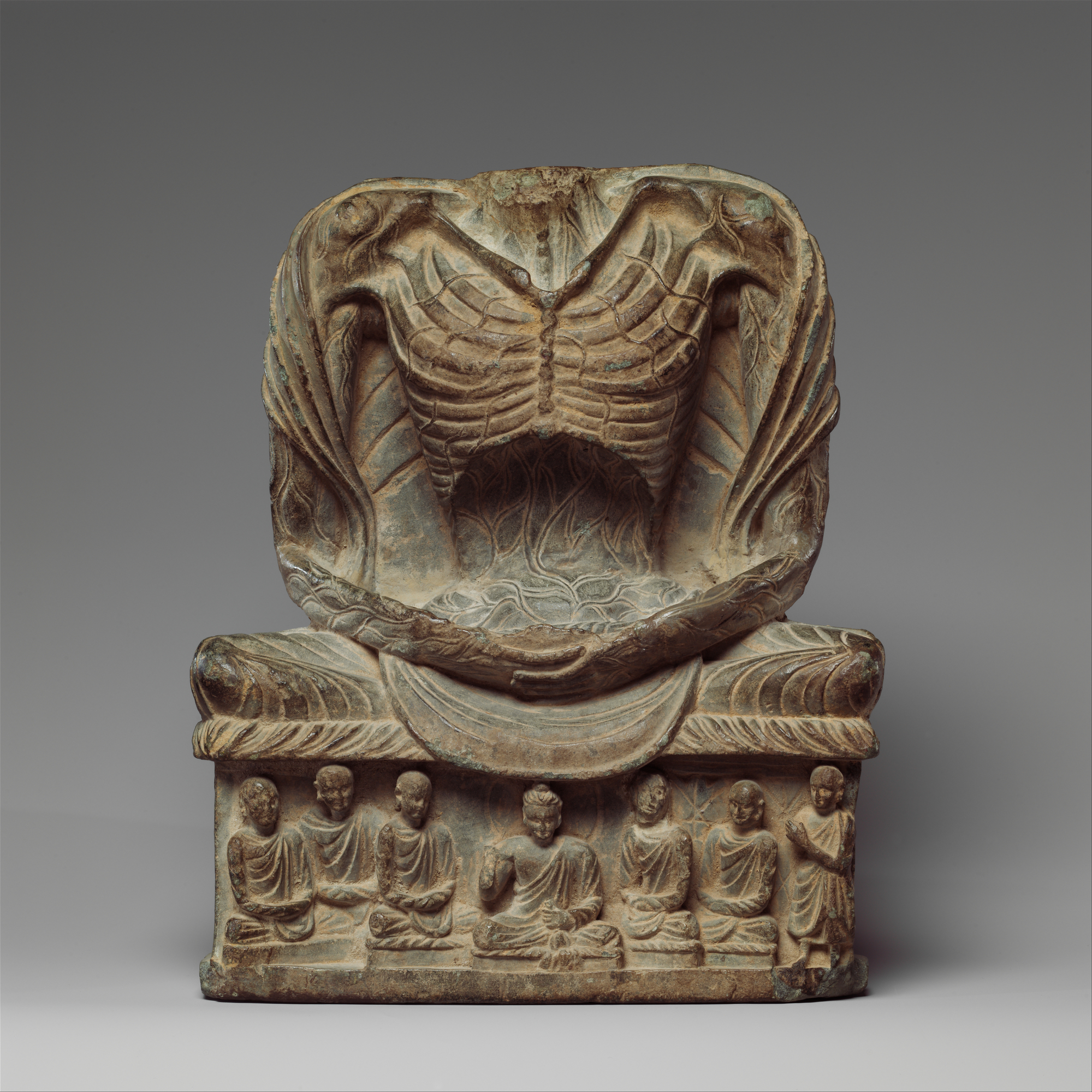
Fasting Buddha Shakyamuni, 3rd–5th century Kushan period, Pakistan/ancient Gandhara, 27.8 cm high (The Metropolitan Museum of Art)
Buddhism and the Buddha
The social caste system as described by Hindu Dharma was likely one of the biggest factors in the development of Buddhism. Buddhism developed in reaction to the established religion in India at the time—Hinduism (Brahminism). Buddhism, in contrast to Hinduism, has a single founder and while there is no singular text there are texts that outline the teachings of the Buddha as the great and exemplary teacher.
Buddhism was founded by one individual, Siddhartha Gautama, sometime in the 6th or 5th century B.C.E. Prince Siddhartha Gautama’s biography has very much become a part of the foundation of the Buddhist teachings.
Prince Siddhartha Gautama lived a cloistered life of ease and abundance. At the age of 29, he came across a sick man, an old man, a dead man, and an ascetic. Siddhartha had never seen these unpleasant aspects of life before and was profoundly moved and confused. He could no longer ignore the existence of suffering in the world and live his life of privilege, knowing that old age and death are our inevitable fate. It was at this time that he chose to depart from his sheltered life to become an ascetic and find the truth about the universe.
The middle way
He removed his jewels and rich robes forever, cut his hair and went into the forest, and became an ascetic where he studied with a variety of sages and yogis, but he was unsatisfied with their teachings. He also practiced several types of self-mortification—most importantly starvation, because he wanted to concentrate exclusively on his spiritual advancements. These searches proved fruitless and he finally came to the realization that the Middle Path (avoiding extremes) was the path towards enlightenment. The middle path teaches adherents to avoid extremes. For Siddhartha that meant neither a life of luxury as a prince nor starving himself.
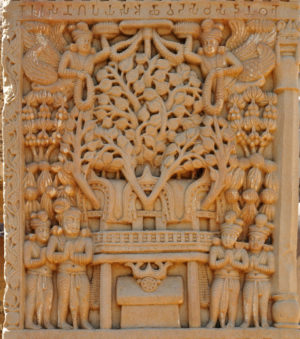
Bodhi tree with shrine, eastern gateway, Sanchi Stupa no. 1, 2nd, 1st century B.C.E (photo: पाटलिपुत्र, CC BY 3.0)
He traveled to a town in northern India called Bodh Gaya, where he sat under a type of tree called a bodhi tree and vowed to remain there until he reached enlightenment. After remaining in that spot in deep meditation for 49 days, he was tested one night by the demon god, Mara (a symbol of ignorance—he is not evil, just deluded). Mara tried to disrupt Siddhartha’s meditation and sent his beautiful daughters to tempt him. Siddhartha remained unmoved, kept his meditation, and thus passed this final trial and gained enlightenment. At the moment of his enlightenment, he came to be known as Buddha, which translates from Sanskrit as “enlightened one.”
The Buddha’s teachings utilized much of the same vocabulary of the Hindus. For example, Dharma for Hindus explains why things are and why they should be. For Buddhists, Dharma came to be defined as the teachings of the Buddha. The caste system became invalid as the Buddha simply denied its relevance towards reaching salvation—as his salvation denied the existence of the self.
For Hindus, salvation comes in realizing that everything is one, everything is in union with Brahman and one’s soul is the same as the universal soul. When the Buddha taught that there was no self, there was no need to attach the self to Brahman. Similarly, in the Hindu context, karma refers to ritual action—darshan and puja—whereas for the Buddhists’ karma has always been an ethical action. For Buddhists, karma (action)—whether good or bad —lay in the intention. Buddha deemphasized Brahmanical rituals by making karma an ethical act and focusing on intention. Moreover, the Brahmin caste who had direct access to the gods through rituals were no longer a privileged class in Buddhism. In Buddhism, anyone who understood the teachings of the Buddha could achieve salvation.
For Buddhists, salvation is gained through the understanding of the ways things really are according to the Buddha’s Dharma. Once an individual has become enlightened they can then reach a state of nirvana. Nirvana is described as the extinguishment of suffering by escaping the continuous cycle of rebirth called samsara. An individual’s ability to reach enlightenment and nirvana is dependent on their understanding of the Dharma. Recall that the goal for both Hindus and Buddhists is to escape the samsaric cycle of rebirth—but each religion’s interpretation of how to do this and what it meant to get off the cycle differed.
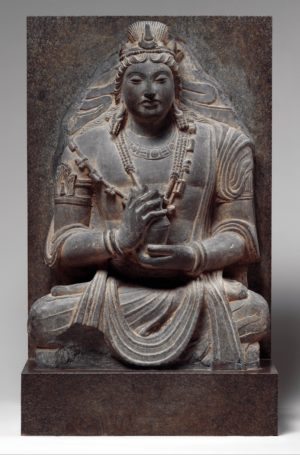
Seated Bodhisattva Maitreya (Buddha of the Future), 7th–8th century, schist, Afghanistan (found near Kabul), 77.8 cm high (The Metropolitan Museum of Art)
The Buddha’s teachings
The basic tenants of the Buddhist faith are called the Four Noble Truths and the Eightfold Path. The Four Noble Truths are meant to uncover one’s eyes of the dust from the secular world and show the practitioner that:
- Life is suffering: it is suffering because we are not perfect nor is the world in which we live perfect.
- The origin of suffering is attachment or desire: attachment to transient things and ignorance thereof. Objects of attachment also include the idea of a “self” which is a delusion, because there is no abiding self. What we call “self” is just an imagined entity, and we are merely a part of the ceaseless becoming of the universe.
- The cessation of suffering can be attained through the detachment of desire and craving.
- The end of suffering is achieved by seeking the middle path. It is the middle way between the two extremes of excessive self-indulgence and excessive self-mortification, leading to the end of the cycle of rebirth.
The middle path can be achieved by following the Eightfold Path to end suffering and begin the course of reaching nirvana. The Eightfold Path requires the practitioner to seek:
- Right or Perfect View: is the beginning and the end of the path, it simply means to see and to understand things as they really are and to realize the Four Noble Truths.
- Right Intention: can be described as a commitment to ethical and mental self-improvement.
- Right Speech: is abstaining from the use of false, slanderous, and harmful words which hurt others.
- Right Action: means to abstain from harming others, abstain from taking what is not given to you, and avoid sexual misconduct.
- Right livelihood: means that one should earn one’s living in a righteous way and that wealth should be gained legally and peacefully.
- Right Effort: is the prerequisite for the other principles of the path as one needs the will to act or else nothing will be achieved.
- Right Mindfulness: the ability to contemplate actively one’s mind, body, and soul.
- Right Concentration: the ability to focus on the right thoughts and actions through meditation.
Buddhist practice
During the time of the Buddha, there was only one school of Buddhism, which is the one that the Buddha taught; however, over time there came to be different sects of Buddhism. These Buddhist sects were produced by fissures within the monastic order. Such fissures occur in differences in practice not in belief in the doctrine. In other words, regardless of what sect of Buddhism one is talking about, all adhere to the Buddha’s doctrine of the Four Noble Truths and the Eightfold Path. Two major schools of Buddhist thought are Theravada and Mahayana Buddhism.
Theravada Buddhism
Theravada translates to “the School of the Elders” since it is believed by some to be closer to the Buddha’s original teachings. According to Theravada Buddhists, each person is responsible for their own enlightenment. There are teachers and models, and the Buddha is exemplary, but, everyone must ultimately reach enlightenment by their own volition. Today, Theravada Buddhism is practiced in much of mainland Southeast Asia and Sri Lanka.
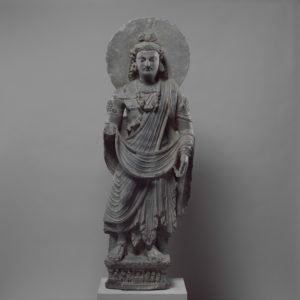
Standing Bodhisattva Maitreya (Buddha of the Future), c. 3rd century, gray schist, 163.2 x 53.3 x 20.3 cm, Gandhara (Pakistan) (The Metropolitan Museum of Art)
Mahayana Buddhism
Mahayana Buddhism was a school that developed in c. 100 C.E. Mahayana literally means: the “big vehicle.” It is a big vehicle that transports more sentient beings off the samsaric cycle towards enlightenment and nirvana. One of the cornerstones of Mahayana Buddhism is compassion, which is visualized in the appearance of the bodhisattvas. Bodhisattvas are altruistic enlightened beings that vow to delay their own parinirvana (final nirvana) until every sentient being reaches enlightenment. Mahayana Buddhism is most commonly practiced in East Asia and Vietnam.
Differences
Where Theravada and Mahayana differ is that Mahayana regards becoming a bodhisattva as the ultimate goal. Therefore depictions of bodhisattvas are frequent in Mahayana art. Another fundamental difference between the two schools is how they regard the character of the Buddha. Mahayana considers the Buddha to be nearly divine in nature—he is superhuman and as such, he is worshipped in Mahayana Buddhism. Theravada considers the Buddha an exemplar, the great teacher.
Decline of Buddhism in India
By the 13th century, Buddhism had largely disappeared from the country of its birth, though it has been kept alive in various forms across Asia. In fact, it is the single most important shared cultural phenomenon found throughout Asia was the transmission and adoption of Buddhism.
Additional resources
Hinduism and Hindu art on The Metropolitan Museum’s Heilbrunn Timeline of Art History.
Buddhism and Buddhist art on The Metropolitan Museum’s Heilbrunn Timeline of Art History.

